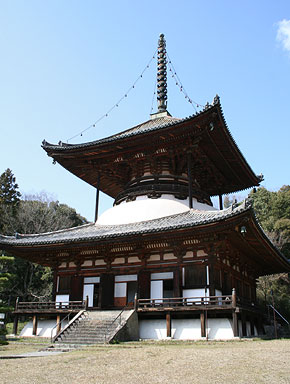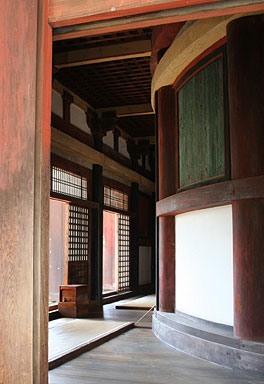| Lit.
Large pagoda. A 2-storied pagoda. A large pagoda of the *tahoutou
多宝塔 type, with a square lower story with an attached pent roof *mokoshi
裳階, a cylindrical upper section and pyramidal roof. The only three daitou
exant are those at Negoroji 根来寺 (1492-1547) in Wakayama prefecture, Kongoubuji
Saitou (west pagoda), 金剛峯寺西塔 (1834) in Wakayama prefecture and Kirihatadera
切播寺 (1618), Tokushima prefecture. Daitou are distinguished from ordinary
tahoutou only by being 5×5 bays instead of the usual 3×3 bays. The
pagoda at Negoroji is 30.85m high. The interior of the pagoda has twelve
pillars *suirinbashira
水輪柱, also called *naijinbashira 内陣柱, that circle the core of the building
*moya 母屋, and are connected
by rainbow beams *kouryou
虹梁. The core has four very heavy pillars *shitenbashira
四天柱, which have the largest diameter of all the pillars in the building.
The pagoda has steps which are centered on each side of the structure and
lead to the Buddhist alter *butsudan
仏壇. The interior of the Negoroji Daitou is considered to best represent
the true daitou style. Daitou as well as tahoutou were
considered to be important buildings among the seven main halls in the Shingon
真言 sect. The Daitou at Kirihatadera was originally
located at Sumiyoshi Taisha Jinguuji 住吉大社神宮寺 and moved to its present site
during the Meiji period. It is thought to be unique because
it has a square upper story instead of the typical, cylindrical, white plastered
type that curves at the top above the pent roof. It is 5-bays square (10m
) on the lower story and 3 bays square on the upper one. All its pillars
are circular. The bracket complexes are 4-stepped *yotesaki
tokyou 四手先斗きょう. This pagoda differs from the tahoutou plan
in that the pillars are arranged in a concentric square instead of the typical
circular arrangement. This is the only surviving completely square, 2-storied
daitou. |


